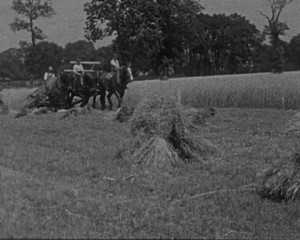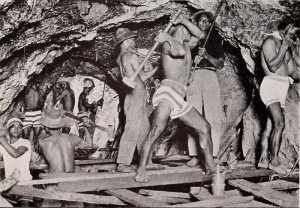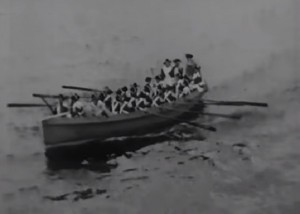
This film shows farm activities in Norfolk, still mainly done without the aid of machines.
"To make clear the entire course of sanitary milk production, from pasture to home table, the State of Illinois Department of Public Health, in Springfield, Ill., is using a two reel, 16mm. film entitled Milk, Its Production and Pasteurization. Produced by Dr. A. C. Baxter, ACL, assistant director of public health, the film presents in interesting and informative sequences the modern technique of dairy farming and the relation of the department to it." Movie Makers, June 1934, 262.

"An outstanding example of industrial record filming is Mining Chrome Ore in New Caledonia, by Enoch Perkins, ACL. Probably no amateur film ever was made under more unfavorable conditions and with as little opportunity to secure special equipment to meet them. Yet the photographic quality of this film is very high and it stands as a tribute to Mr. Perkins's ability to overcome obstacles. A large part of the picture was made in a mine where the atmosphere was so charged with moisture that it was necessary to stop and wipe the lens dry every few minutes. Although lighting was a tremendous task and often cables over a thousand feet long were required, the mine scenes are accurately exposed and well photographed. The picture gives a complete record of mining ore from the solid wall of the tunnels to the loaded freighter. It was filmed from an engineer's point of view and for the specific purpose of record; however, smooth continuity and editing maintain audience interest." Movie Makers, Dec. 1933, 500, 522.
"This film shows Ojibwe women at Squaw Point, Leech Lake tanning hides and making moccasins decorated with beadwork and an Arikara or Hidatsa woman at Fort Berthold, North Dakota tanning cow hide and doing quillwork on clothing." Minnesota Historical Society.

"The subject of 'Nation Builders'—the history of Australia—is without doubt the most ambitious ever undertaken by any amateur filmer. The fact that the project was successful is in itself a tribute to Sherlock's skill. Granted that in connection with the 150th anniversary of his nation's founding there were pageants re-enacting historic events and an opportunity for an alter filmster to photograph them: but how many times have not other amateurs scored dismal failures trying the same thing? Filming such a pageant, it is all too easy to capture only the impression of history actually happening. The twentieth century background which must so often have been just beyond the camera-lines was never permitted to intrude upon his eighteenth and nineteenth century action." American Cinematographer, Feb. 1939, 61.
"Un-staged documentary footage shot and edited by Sallie Wagner. Sallie's description of the film: 'Wide Ruins and area, farming Navajos, Black Rock - Medicine Man, Cut Hair plowing, Joe Toddy following Cut Hair, planting, Patsy Martin standing on Cultivator, Jim House's wife husking corn, Paul Jones helping husk corn, sheep dipping at Ganado, Dwight Wagner viewing sheep dipping, wool shearing at Wide Ruins, loading sheep at Chambers, tall man in tan outfit Bill Cousins, Bent Knee sitting on fence, Crip Chee's grandson in closing scene'." New Mexico States Archives.
"Part one of Navajo Weaving. Un-staged documentary footage shot and edited by Sallie Wagner. Sallie's description of the film: 'Crip Chee's Hogan, Milton Davis holding lamb, Eleanor Johnson from Hawaii, Bill Lippincott, Grandstaff (center), Hosteen Glish - purchase of rams for up-breeding, shearing at Wide Ruins, Jim House on horseback, Joe Toddy taking wool out for sorting and sacking for shipment, dipping in chute, Walter Ashley putting sheep in dip, Little Shorty to left, washing the wool before spinning, Patsy Martin sorting, Sybil Shorty carding wool, Dorothy Lippincott Stockton trying to learn, Louise Dale spinning wool, washing of yarn, gathering plants for dyes, Little Woman (Captive of Kit Carson - survived the Long March) grey-haired woman - stripping bark from Juniper root for red dye'." New Mexico States Archives.
"Part two of Navajo Weaving. Un-staged documentary footage shot and edited by Sallie Wagner. Sallie's description of the film: 'Rose Martin, Patsy Martin warping, Sybil Shorty weaving, looms built by the Lippincotts at the Wide Ruins Indian School, Madge Clark, Dan Gaddy, and John Joe in front of the trading post, Bill Lippincott in patio with rug display, Bill Cousins selling rug to tourist'." New Mexico State Archives.
"Title, 'Nequasset Bridge is on new location of Route 1 near the famous ship-building city of Bath.'" oldfilm.org
Total Pages: 8